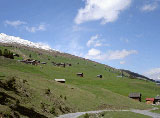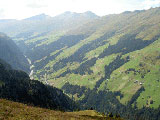Scattered Walser settlements in Graubünden
The Walser didn’t bring the feed to the cattle; rather they bought the cattle to the feed. They “placed” the cattle in one stable till they had eaten all the hay kept there and then moved them on to another. Due to the large number of buildings that each farm\enterprise had, and the relatively small quantity of hay kept in individual stables the building method was very simple. Often the stable only consisted of a cattle shed and a hay room. For the cattle shed the building timber cut with a wide axe was used, whereas the hay room was from round wood (tree trunks) as this could be felled in the nearby forest and “aufgetrölt” (rolled up). With the building of stables in the different valley regions, naturally different building methods developed. This was particularly so in the Rheinwald, Vals and Avers where the ground floor and the corners of the hay room are built in natural stone brick and the roof is covered with stone plates. |  |
 |
The Walser settlement in Graubünden is therefore predominately made up of scattered housing settlements. This is particularly pronounced today in Avers, Obersaxen, in Safien and Tenna, Furna, Valzeina, Davos-Unterschnitt and Langweis. Today, Obersaxen alone has 29 large and smaller farm settlements and niches. Also Walser settlements such as Vals or Nufenen that present themselves today as villages were in former times, scattered housing settlements. The central point was often only the church with the parish building. It is “Platz” where a whole set of Walser settlement in Graubünden can be found. (Davos, St-Antönien, Vals, Klosters, Safien). |







